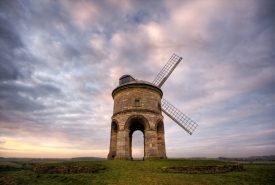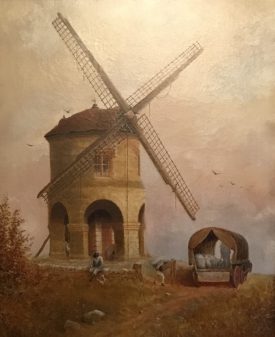The Chesterton Windmill is a famous feature of the Warwickshire landscape and can be seen from several miles away. It stands on a hilltop overlooking the Roman Fosse Way about five miles south-east of Warwick. The mill was built in the years 1632-1633 and remained in use until about 1910 when its machinery ceased to work. It was restored from 1965-1971 by Warwickshire County Council in collaboration with the Society for the Preservation of Ancient Buildings and the then Ministry of Public Building and Works.
The building of the mill
At the time the windmill was built, Chesterton Manor belonged to Sir Edward Peyto (1590-1643), a prominent figure in early 17th century Warwickshire. Sir Edward had interests in architecture and mathematics and knew several of the leading architects of the day, including Inigo Jones (1573-1652). There is no evidence however that Inigo Jones designed the windmill, and it is possible that Sir Edward was his own architect.
Some of the building accounts for the windmill have survived and we know the names of several of the craftsmen, how long they worked and how much they were paid. For example, John Richardson and his son were employed as stone masons and were paid 15s 6d for half a day digging stone at the quarry, and 15 days’ work at the windmill itself. It is also recorded that sailcloth for the mill was bought at 9d per yard from a Mr Saunders, who supplied 97 yards for £3 12s 9d.
Unique structurally and mechanically
The mill is set on six pillars linked by semi-circular arches. Originally there was a central timber structure within this open space, containing a staircase and storage area. The mill machinery itself is set on two floors inside the stone tower – the lower houses the two pairs of millstones and the upper the actual driving mechanism. The sails have a 60 foot span and carry 450 square feet of canvas.
The machinery was repaired in 1776 and again in 1860. Chesterton Windmill continued to be used until shortly before the First World War when the winch which turned the sails into the wind failed to operate, and milling became impossible. The last miller, William Haynes, moved to the windmill at Harbury about a mile away.
Chesterton Windmill is now in the care of Warwickshire County Council and is opened to the public on an occasional basis by the Warwickshire Museum Service.
Text reproduced by kind permission of Warwickshire Museum Service. The Historic Environment Record for Chesterton Windmill can be found here.









Comments
Don’t know if this is true but according to a story told by my great-aunt, Kath Male, an ancestor from her side of our family once owned Chesterton Windmill but was cheated out of it in a card game!
Add a comment about this page